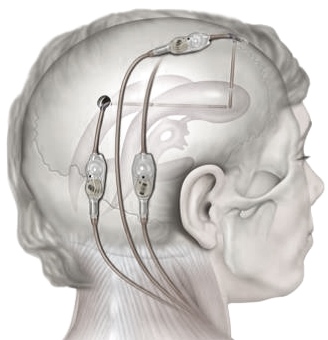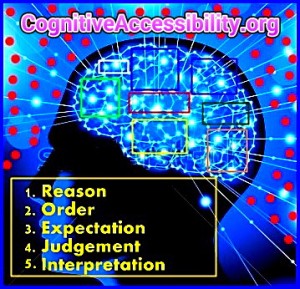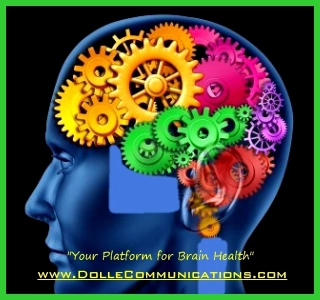This blog discusses mHealth mobile phone apps and accommodations for living with hydrocephalus.
I initially wrote this in 2015 under the title “Spread Awareness of Hydrocephalus on Rare Disease Day.” But then following several large updates of content, on April 18, 2016, I changed the title to “Mobile Apps and Accommodations for Living with Hydrocephalus,” which I feel more aply represents its content now. I discuss many of the everyday challenges faced by persons living with hydrocephalus, and discuss my experiences with specific mHealth mobile apps and accommodations-solutions needed for everyday living.
Hydrocephalus is a neurological disorder where CSF (cerebral spinal fluid) is not sufficiently cleared from within and around the surface of the brain – from a variety of etiologies. The fluid then abnormally collects in the brain’s ventricle compartment thereby exerting abnormal and often dangerous pressures on critical structures of the brain. It is normal to have CSF in the brain, as it is produced in the choroid plexus at a rate of about 20cc per hour. It’s primary purpose is in regulatiion of blood pressure (BP) and intracranial pressure (ICP). It also circulates up & down the spine and helps to circulate needed nutrients throughout the brain. Hydrocephalus then develops when the brain is not able to clear CSF fluid at the same rate it is produced, more often resulting in swelling of the ventricles – except in NPH, or normal pressure hydrocephalus, where there may be limited or no swelling, and normal amounts of pressure.
Hydrocephalus occurs in utero and shortly after birth in 1 of every 1000 births. It also occurs in children from cysts and tumors, and somewhat also in adults. It occurs post trauma through subarachnoid bleeding, and idiopathicly, or naturally, from anatomical malformations of the brain and brain-stem, and from aging. Its overall prevalence in the U.S. is estimated at about 40,000 to 50,000 new cases each year. But due to its broad spectrum of causes or etiologies, hydrocephalus has been accepted into the rare diseases database. Many scientists continue to refer to hydrocephalus as a rare disease because of its association with genetic birth defects. The illustration below identifies where CSF is produced and circulated within the brain.

Brain Diagram of Ventricles often Enlarged in Hydrocephalus
DolleCommunications is my neurosciences blog I launched in 2010 after becoming affected by hydrocephalus following a 1992 auto accident and concussion. The photo of me below was taken in 1998 after one of the shunt surgeries where I had used my newly developed DiaCeph Test mHealth method to help direct replacement of the needed medical device components on my CNS shunt system.

Stephen Dolle invented his DiaCeph Test following his 1996 FDA petition, which was then used to direct this 1998 shunt surgery
A CNS (central nervous system) shunt is the most common form of treatment for hydrocephalus. It is a two or three piece catheter with a one-way pressure valve that more often drains into the abdomen, or peritoneum, where it is termed a VP shunt. Alternately, it can drain into the heart (VA shunt), or draw fluid off the spinal canal into the abdomen (LP shunt). Over the last 20 years, a newer surgical procedure, a 3rd ventriculostomy, has been developed where a small opening is made in one of the ventricles (usually the 3rd), which if successful, allows for proper circulation and clearance around a an aqueduct blockage and can negate dependance on a CNS shunt. Only 10-15 percent of those with hydrocephalus will benefit from this procedure.

Great pic NHF members affected by hydrocephalus at a 2015 Orange County fundraiser.
It is common knowledge today that shunt technology is in need of modernization. Present day treatment outcomes (esp. with CNS shunts) often leave individuals with significant quality of life challenges with no shunt diagnostics to provide early warning shunt malfunction or accidental reprogramming, which is all to common and can result in brain damage and/or blindness. Since my onset in 1992, I’ve undergone 12 shunt revisions.
Living with hydrocephalus and especially a CNS shunt presents a number of key challenges, most notably, shunt malfunctions and corrective surgery, but also frequent headaches, cognitive and memory difficulties, challenges with balance and hand/eye coordination, and difficulty adapting to a noisy and complex world where the necessary accommodations are widely unavailable today. I discuss some of the challenges and much needed accommodaitons for hydrocephalus further below.

Shunt Illustration for Hydrocephalus
I became involved as an FDA patient advocate and inventor in hydrocephalus several years after my onset of hydrocephalus. As a patient advocate, I authored a critical 1996 citizen’s petition to the Food and Drug Administration (FDA), plus made recommendations at the 1999 STAMP Conference in Bethesda MD. I’ve also written FDA position papers and recommendations for the oversight of shunt technology, and spoke at the 1999 STAMP Conference in Bethesda, Maryland.

Stephen Dolle in Washington, D.C. for the FDA’s Hydrocephalus STAMP Conference in 1999.
After writing my FDA petition on CNS anti-siphon shunts in 1996, my research led me to design and patent a non-invasive monitoring system for hydrocephalus, I named the DiaCeph Test. It initially was to run on a PDA. But I could not raise the necessary funding to make it. The DiaCeph Test today could be made into a mobile phone data and text app. Most of the development costs today is still from burdensome FDA guidance on mHealth apps. If it were available, it would revolutionize the care of hydrocephalus.

The DiaCeph App Creative Brief details its design and unique features in monitoring of the disorder hydrocephalus
DiaCeph Test could be Mobile Phone App
In 2009, after many years of patient advocacy and answering inquiries from affected patients, I began offering patient consults for a fee. Most of my patients have been those affected by complex hydrocephalus, and with unresolved challenges. Unresolved complaints and unsatisfactory outcomes are common in hydrocephalus – as high as 70 percent of all patients with hydrocephalus.
I am also very involved with weather apps and barometric pressure monitoring. A link to my primary blog on this is listed further below.
My biggest new discovery in this space comes from a study I undertook in 2017 with the MigraineX ear plugs used in the management of headache, but also in sound suppression. I found that insertion of MigraineX ear plugs before, and even after a harmful sound exposure has occurred, can lessen the associated headache, irritability, cognitive, and SPD complaints by 50% or more. So I carry my MigraineX ear plugs with me all the time to manage sound exposure & associated SPD complaints. They are particularly helpful amid noise from construction, machinery, malls, restaurants, theatre halls, and more. They sell for about $12 on Amazon and at many drug stores.
I have also been undertaking barometric pressure monitoring now with my Samsung phone’s built in barometric pressure sensor. The built in sensor can display sharp short term changes in pressure that weather sites & apps do not display. Most newer high end smart phones have this sensor built in. But you need an app to get the display. For this, I currently use uBarometer Pro. I have been able to correlate these short pressure changes as triggers of pain and headache.
The web link (web page) below describes how to obtain a consult for hydrocephalus, shunt monitoring, and mHealth monitoring with custom apps, and DiaCeph forms and user instructions.
Hydrocephalus & Shunt Monitoring Consults

In 2004, I became involved in drum circles after earlier playing piano, vocal work, and some stage & film. I initially used piano as a form of therapy for my challenges, then later guitar, then in 2004 percussion. I immediately realized a call to become more involved in drumming, and I began to take classes, and eventually help put on drum circle events. Today, I am very involved in drum circles and drumming for the brain & wellness and for disorders like hydrocephalus.
Drumming Therapies for Wellness and Neurological Disorders
On Sept. 24th, 2015, I held two drumming workshops at the 2015 NHF Patient Power Conference in Anaheim, CA. My methods help with others with balance, coordination, cognition, and communications challenges. SEE info in the flyer below.

Seniors came alive in this 2010 drum circle for wellness and movement.

Drumming workshop for balance and movement challenges in living with hydrocephalus
One of the more problematic challenges with hydrocephalus, and most neurological disorders, is with cognitive accessibility and it’s related sensory processing disorder, or SPD. These challenges are often disabiling and occur in hydrocephalus and neurological and learning disorders such as autism, ADHD, PTSD, Parkinson’s, stroke, post tumor, addiction, and even migraine. I have written about both fairly extensively. And own the domain CognitiveAccessibility.org – which I am yet to host a web site. I currently have it pointing to a supporting temporary page on my main web site.

CognitiveAccessibility.org
CognitiveAccessibility.org
COGNITIVE ACCESSIBILITY describes the array of accommodations and protections needed today by affected individuals. Without these protections, cognitive dysfunction and often one’s mental health state are easily exacerbated (made worse) by exposure and stress of unhealthful cognitive triggers. In fact, today there is a large lawsuit brought by families with autism against Disney World for failing to offer cognitive disability access to park rides. The science is real. I’ve experienced thousands of first hand accounts.
Common cognitive triggers include loud TV & radio commercials, loud helter skelter music, noisy construction equipment and machinery, bright lights, and powerful odors. When these triggers are present and not managed properly in public places, they restrict access by persons susceptable to it. Today we know that mental health and physical brain changes go hand in hand, meaning, one affects the other. This next blog describes many of the key sensory challenges in sensory processing disorder (SPD) and sensory challenges in hydrocephalus, and related disorders. Below, is also a recent diagram on the brain’s mechanisms involved in sensory processing disorder.

Brain centers involved in SPD or sensory processing disorder, courtesy of UCSF
New Insights in Management of (SPD) Sensory Processing Disorder
The protections cited are for public facilities where the triggers can often prevent an affected individual from safe and healthful use. It is said be a part of current disability law (i.e. autism v. Disney lawsuit). But rarely is enforced. Most people are unaware of the science and cause and effect of the triggers to behavioral melt-downs. In addittion to sensory protections, there needs to be better understanding of directions on UIs of web sites, signage, directions, product labels, etc. Today, I find you’re more likely to see a foreign language accommodation, than a cognitive disability one.

TSA Cares Logo
Airport Travel, Screening, and TSA Services for Persons with Hydrocephalus
This blog features updated information on TSA Meet and Assist services for passengers with disabilities, and safety information on airport scanners for safe use by persons with programmable shunts for hydrocephalus. I also cover use of TSA Meet and Assist services for persons with cognitive disabilities, and information on the Air Carrier Access Act.
Airport scanners had earlier worried me as I live with a programmable CNS shunt for hydrocephalus, and I have been over-exposed to radiation from CT brain scans. With my Codman Certas CNS shunt valve, I do not go thru the metal detectors at airports or anywhere (even though some state magnetic field is safe for my shunt). I recommend that if you have any type of programmable CNS shunt, that you do not go thru metal detectors.
I’ve since updated this blog with newer information on the safe use of airport scanners.
The next two blogs list helpful information on mobile apps for sensory processing disorder, as well as apps I use and recommend for living with hydrocephalus.

Blog: Mobile Sound Apps for Hydrocephalus & Sensory Processing Disorder

eWeather HD App helpful in Managing Weather related Migraine Headache
This next blog is a discussion of how to best select and design medical and mHealth apps. It comes from my many years of experience in mHealth & diagnostic medicine.

mHealth Apps in Neurology
Design and Best use of mHealth Apps
Perhaps my most creative public outreach is the fun HydroPowered.org web site for hydrocephalus. I created this in 2013 as a fun platform to share art, technology, and super-hero stories among those affected by hydrocephalus.

HydroPowered.org Share the Passion for Hydrocephalus
Blog on HydroPowered.org Platform Connects Hydrocephalus Families
Let’s undertake some effort in hydrocephalus for Rare Disease Day. If needed, I am prepared to call upon “The Hulk” for a little extra help.

The Hulk comes to the aid of persons with cognitive disabilities & SPDs, crushing this noisy tree trimming machine.
Apps & Web Sites I Recommend for Persons Living with Hydrocephalus
Android Play Store Elecont HD Weather App link
Apple iTunes Store Elecont HD Weather App link
My *Blog on eWeather HD* App and How to get FREE Android Download
My Blog on Tips for Sound Sensory Processing Disorder
Smart Tools Page on the Android Play Store
Smart Tools Apps on the iTunes Apple Store
Smart Tools Instruction Manual
Tips on Airport Travel, Screening, and TSA Services for Persons with Hydrocephalus
Drumming for Wellness workshops
Drumming Therapy Case Study in a Child with Cerebral Palsy and Autism
Shunt Monitoring and Consults for NPH & Hydrocephalus
DiaCeph Monitoring Method hopes to be new Mobile App
If I’ve left out any my blogs or apps, please let me know. If I may help you with hydrocephalus mobile apps, hydrocephalus consults, or drumming therapy for hydrocephalus, or if you are interested in furthering the development of the DiaCeph Test or other mobile apps for hydrocephalus, let me know. Contact me via my info below. Feel free to CLICK and SAVE my contact JPEG card.
Stephen Dolle
Email: contact[at]dollecommunications[dot]com
Dolle Communications
HydroPowered.org
StephenDolle.com


[…] Spread Awareness of Hydrocephalus on Rare Disease Day 2015 […]
LikeLike
[…] Weather App helps in Management of Weather-related Migraine […]
LikeLike
[…] support of hydrocephalus and my yet diagnosed neuromuscular disorder, I would like to share my Hydrocephalus Blog for Rare Diseases Day. Seems my duties never […]
LikeLike
[…] sensory processing disorder, or SPD, and with difficulty in cognition following brain injury and hydrocephalus. The spectrum of symptoms seen following concussion includes: sensitivity to lights, sounds, and […]
LikeLike
[…] About Hydrocephalus […]
LikeLike
[…] DolleCommunications Blog of Apps & Tips for Hydrocephalus […]
LikeLike
[…] mHealth Tools & Accommodations for Living with Hydrocephalus […]
LikeLike